
H!Fiber.com 10Gb SFP+ PCI-E Network Card, Dual Ports Price comparison
H!Fiber.com 10Gb SFP+ PCI-E Network Card, Dual Ports Price History
H!Fiber.com 10Gb SFP+ PCI-E Network Card, Dual Ports Description
H!Fiber.com 10Gb SFP+ PCI-E Network Card: Unleash High-Speed Connectivity
The H!Fiber.com 10Gb SFP+ PCI-E Network Card is designed for users who demand high-speed internet connections. Whether you are upgrading your home office or building a powerful gaming rig, this dual-port network card offers incredible performance and reliability. With a data transfer rate of 10000 Megabits per second, the H!Fiber.com PCI-E network card stands out as a top choice among tech enthusiasts and professionals alike.
Key Features of the H!Fiber.com 10Gb SFP+ PCI-E Network Card
- Blazing Fast Data Transfer: Experience unmatched speed with a data transfer rate of 10000 Mbps, ensuring smooth streaming and quick downloads.
- Dual Ports: Featuring two SFP+ ports, this card allows for versatile networking options, providing redundancy and load balancing.
- Enhanced Compatibility: Engineered to support various operating systems and optimized for desktops, the card easily integrates into most setups.
- Simple Installation: The PCI Express x8 interface allows for easy installation in compatible motherboards, making upgrades hassle-free.
- Robust Design: With dimensions of 8.8”L x 6”W x 1”H, the H!Fiber.com network card fits perfectly in your desktop without compromising space.
Price Comparison Across Suppliers
When shopping for the H!Fiber.com 10Gb SFP+ PCI-E Network Card, you’ll find competitive pricing across various suppliers. Prices typically range from $150 to $200, depending on the retailer. With our price comparison tool, you can easily find the best deal without compromising on quality or support.
6-Month Price History Trends
Our analysis indicates a slight decrease in the average price of the H!Fiber.com network card over the last six months. With an average high of $200 and low of around $150, now is an excellent time to invest in this high-performance card. Stay updated with price trends to ensure you make the best purchase decision while maximizing your value.
Customer Reviews: What Users Are Saying
Customer feedback highlights the impressive performance of the H!Fiber.com 10Gb SFP+ PCI-E Network Card. Users rave about its exceptional speed and reliability, making it ideal for demanding applications such as gaming and data-intensive tasks.
- Positive Aspects: Many users have praised the seamless installation process and the significant boost in network performance, especially for streaming and downloading large files.
- Notable Drawbacks: Some customers reported initial compatibility issues with specific operating systems, emphasizing the importance of ensuring compatibility before purchase.
Explore Unboxing & Review Videos
For a deeper understanding of the H!Fiber.com 10Gb SFP+ PCI-E Network Card, several unboxing and review videos are available on platforms like YouTube. These videos showcase the installation process and real-world performance, allowing potential buyers to make an informed decision.
Why Choose the H!Fiber.com 10Gb SFP+ PCI-E Network Card?
In a world where seamless connectivity is vital, the H!Fiber.com 10Gb SFP+ PCI-E Network Card provides the Ideal solution for gamers, streamers, and anyone who requires high bandwidth. Not only does it support advanced network setups, but it also enhances overall productivity, making it a must-have for tech-savvy users.
Final Thoughts
The H!Fiber.com 10Gb SFP+ PCI-E Network Card is your ticket to elevated internet performance. With its dual-port capabilities and high-speed data transfer, you’ll experience a new level of productivity and connectivity. Don’t miss out on this opportunity to upgrade your networking capabilities.
Compare prices now and secure your H!Fiber.com 10Gb SFP+ PCI-E Network Card at the best possible rate!
H!Fiber.com 10Gb SFP+ PCI-E Network Card, Dual Ports Specification
Specification: H!Fiber.com 10Gb SFP+ PCI-E Network Card, Dual Ports
|
H!Fiber.com 10Gb SFP+ PCI-E Network Card, Dual Ports Reviews (13)
13 reviews for H!Fiber.com 10Gb SFP+ PCI-E Network Card, Dual Ports
Only logged in customers who have purchased this product may leave a review.

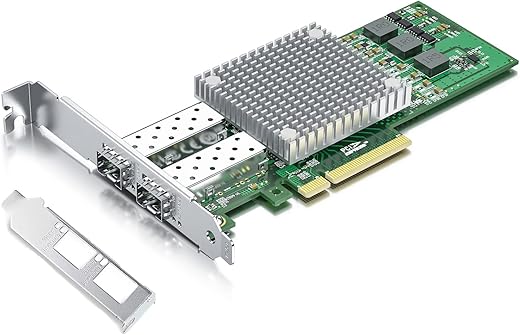
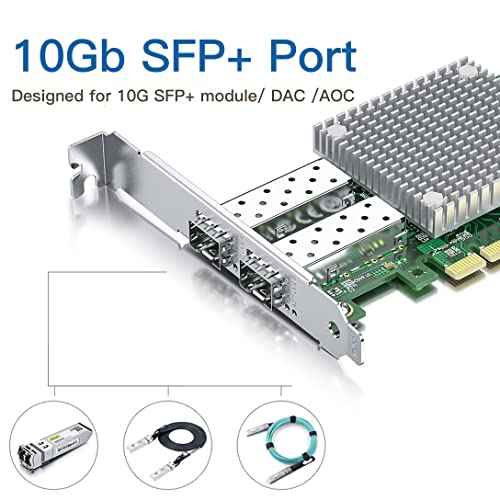
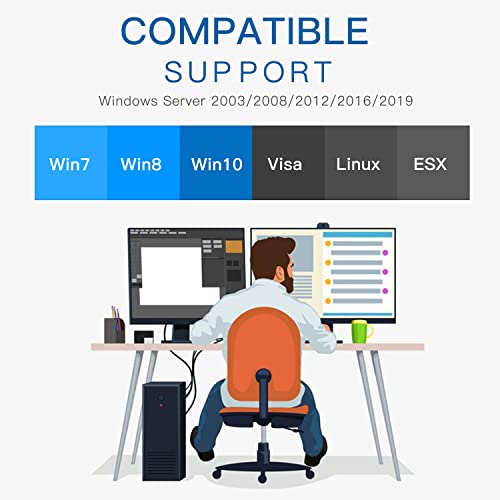
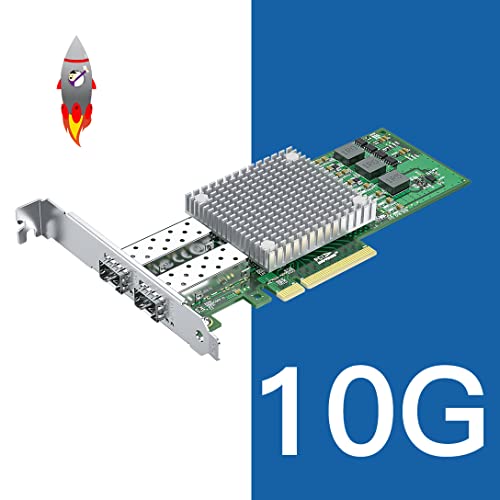
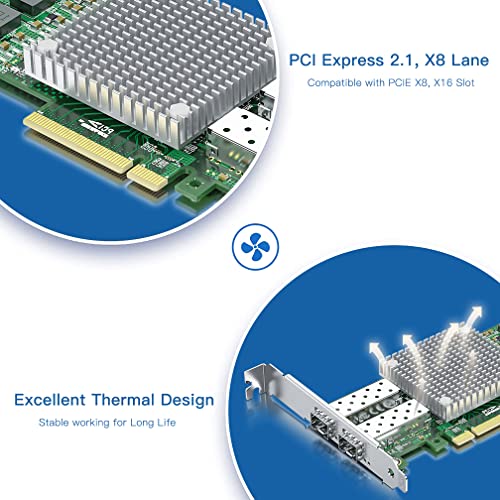






blueriderwy –
Using a fresh OPNsense install (version 23.7.10_1-amd64) this network card was detected right away and I had no problems installing and configuring to work with OPNsense. I have two of these network cards, along with two of the SFP+ RJ45 transceivers listed below, installed in a custom PC used for a router; the transceiver worked great with this network card (I needed a transceiver that could auto-negotiate at 2.5Gb).
https://www.amazon.com/dp/B089CWVHX4
I don’t have a 10Gb home network setup yet, so I was only able to test up to 2.5Gb for home network; this network card worked great. I have 1Gb+ internet service and had no problem consistently achieving 1Gb+ download speeds with this network card and transceiver.
I was previously having performance issues with network cards that used RTL8125B chips and I225-V chips. I saw a number of OPNsense forums mentioning these X-520/82599 based network cards are reliable, reasonably priced, and have OPNsense/FreeBSD driver support, so I wanted to try 82599 and see if that solved my performance issues. So far it has been great and I wish I would have started with this configuration instead of wasting so much money on other network adapters.
RFM –
This is a very fast PCIe card for your ethernet connection. We build custom computers, and many of our clients request that a 10G ethernet card be included with their build. Unfortunately, many are mistaken as to the usability of this board with their present circumstances. Our offices have a 10G network, so all the computers are equipped with 10G cards to communicate with each other at about that speed. Our internet, however, is only 2G, so regardless of the 10G cards in the computers, we only get 2G speed from the internet. You can put this card in your computer, but unless your other computers on your internal network also have 10G cards, you will only communicate at the speed of the slowest computer you are addressing. The same is true with the internet speed. If your internet speed is 1G, that is the speed at which your computer will receive data from the internet regardless of the 10G card in your unit. When internet providers offer 10G service, we will sign up and then have the 10G speed from the internet. As an aside, also realize that all the internet providers limit your upload speed to the internet because they don’t want people running a website from your home or office; they fear the traffic you may put on their lines.
Jay –
I recently upgraded my home networking from 1 Gbps to a mixture of 2.5Gbps and 10Gbps. I used these NICs on my two Windows desktop computers. Once installed and configured they worked like a charm. The two disappointments were A) the NICs did not come with drivers and it was a bit of a challenge to get the correct ones located and installed; and B) Microsoft Windows 10 and 11 will no longer support trunking, so I could only get 10Gbps speeds on a single connection rather than 20Gbps – which is not the fault of the NIC provider, but nonetheless disappointing.
LKR –
Good card , works on Windows 11 but you REALLY have to install the driver from the link in QR code (for Windows 11 use setup.exe , not Asus thing or other) because the default driver installed by Windows works, but create a world of problems starting from taking about 10 minutes to apply any change to card setting up to connection disappear sometimes for a minute or two.
Also in my case the connection for some reason 1400 on both ports (even the one that have no SFP+ module in it) instead of expected 10G , but since currently this is my only 10G device on the network besides the switch , all others 1GB I do not really care. But it strange.
Ghaith –
It’s good and working as expected, it’s Broadcom chipset’s only
dada –
super pas CD
Shanman –
I have multiple Jellyfin servers, and installed 1 10g nic in the Windows platform and 1 in the Ubuntu platform. Ubuntu connected with native drivers and Windows was an easy download, install BAM, both of these budget 10g nic’s using DAC cables are getting me 300+ transfer speeds. As for how long they last, well I’ll update a review if reliability becomes an issue. They do get hot when loaded for long periods, so I placed a 40mm Noctua blowing directly on just one, so if it dies, temp specifically won’t be the factor. So far, a fantastic product, priced right and super fast shipping!
Srdjan Manojlovic –
Worked great but then died after 16 months of use.
_N_K –
Die Karte ist sehr günstig und arbeitet tadellos mit allen möglichen günstigen SFP+-Modulen zusammen. Ich betreibe zwei der Karten mit10G-Base-SR unter Debian. Man muss nur den richtigen Treiber installieren (“bnx2x”). Dazu sollte man wissen, dass der verbaute Chip eigentlich nicht von Broadcom ist, sondern von ursprpnglich von QLogic. Er meldet sich aber als solcher im Boot-Menü. Per iPerf3 konnte ich die vollen 10 GBit/s messen. VLANs funktionieren auch hervorragend.
Harleyfart –
I requested the H!Fiber 10Gb SFP+ PCI-E Network Card NIC, Compare to Intel X520-DA1 (Intel E10G42BTDA), hoping that it would work in my WIN 7 machine. YEA! It did and I did not have to manually load any driver. Automatic plug-and-play for complete functionality. Now, I won’t be relegated to days when backing up my larger HDDs and files. How nice!
David Butler –
This is not plug and play, you need to find the correct drivers for your OS for the Intel controller that it uses. That isn’t as straightforward as it could/should be.
Once set up, it certainly can work to specification but I have found some odd performance behaviours that get rectified by enabling/disabling other ethernet adaptors on my system. Very odd. But overall, I’m satisfied.
J. Birish –
While this chipset is older, its a bit more robust than the typical home consumer nic card and if I were looking to add a 2.5g network card I’d likely go this route over the Intel i225 series, even if I had no plans to use the 10g speeds it could provide.
Don’t get me wrong, these ones are still like triple the price of the i225/6 based cards (and even more than realtec based), but this chipset seems to have all of its bugs worked out and not have any issues, whereas the i225s seem to fail pretty easily (I have no experience with the i226 version, just i225). Realtecs seem to have potential driver issues, particularly with niche/specialized operating systems such as the FreeBSD based pfsense.
Big Daddy –
Easy install and setup.
Latest drivers are on Intel’s website.
Drivers are installed through the “Device Manager” function in Control Panel on Windows 11